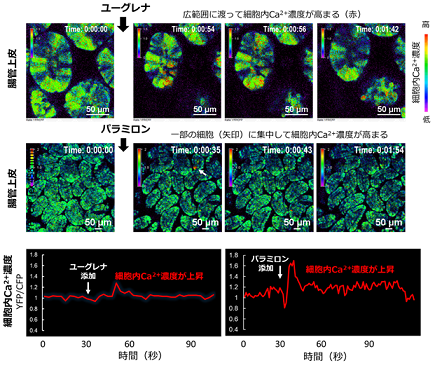Press Releases
* Please note that the news release contains the content at the time of the announcement and may differ from the latest information.
Confirmed research results suggesting that the microalgae Euglena and the unique component paramylon act on intestinal epithelial cells
Focus on the interrelationship of intestinal epithelium-immune system-nervous system
Euglena Co., Ltd.
Euglena Co., Ltd. (Headquarters: Minato-ku, Tokyo, President: Mitsuru Izumo) has collaborated with Associate Professor Takahiro Adachi of Tokyo Medical and Dental University to collaborate with Euglena Co., Ltd. (Japanese name: Euglena, hereinafter "Euglena") and its storage. By observing the effects of the polysaccharide paramylon in the intestinal tract in real time, we obtained research results suggesting that it acts on intestinal epithelial cells as a dietary signal * 1. The results of this research were published in the online version of "Nutrients" on July 30, 2020 as one of the special issues "β-glucan contained in foods and health benefits" (https: // www. mdpi.com/784732).
* 1 A food ingredient that activates intracellular signal transduction. The intracellular calcium concentration is used as an index.
■ Purpose of research
The intestinal tract not only absorbs food nutrients, but is also an organ where the endocrine system, immune system, and nervous system gather, and plays an important role in maintaining homeostasis of the living body. Among them, intestinal epithelial cells not only have the function of absorbing nutrients and water, but also control intestinal bacteria by mucosal formation, maintain the intestinal immune system, and secrete gastrointestinal hormones as endocrine organs to stimulate sensory nerves. It plays various roles such as promoting peristaltic movement and digestion. We have previously reported the Euglena and paramylon act directly on immune cells and sensory nerve cells in the intestinal tract * 2. This time, we investigated the possibility and mechanism of Euglena and paramylon recognition in intestinal epithelial cells, which are closely related to immune cells and sensory nerve cells in the intestinal tract. Euglena and paramylon on intestinal epithelial cells using changes in calcium (hereinafter Ca 2+) concentration involved in intracellular signal transduction as an index.
* 2 Released on March 30, 2020 https://www.euglena.jp/news/20200330/
The results of this research will be presented at the "Japan Society for Bioscience and Biotechnology 2020 Conference" (scheduled to be held from March 25 to 28), and will be announced for the first time at this conference, including content that has academic or social impact. It was recognized that it was selected as an excellent presentation.
■ Research content and results
Euglena and paramylon have been suggested to act on intestinal epithelial cells
Using genetically modified mice in which the calcium biosensor * 3 was expressed systemically, changes in Ca 2+ concentration in intestinal epithelial cells were observed under a microscope (Fig.). Extensive and transient increases in intracellular Ca 2+ concentration were observed Euglena was added to intestinal epithelial cells. With the addition of paramylon, changes in Ca 2+ concentration were concentrated in only some of the intestinal epithelial cells. This suggests that Euglena act on most intestinal epithelial cells, and paramylon acts on specific intestinal epithelial cells.
* 3 The calcium biosensor Yellow Cameleon 3.60 (YC3.60) has a cyan fluorescent protein (CFP) and a yellow fluorescent protein (YFP) in one molecule, and two fluorescent proteins undergo structural changes depending on calcium. Fluorescence changes from cyan to yellow due to fluorescence resonance energy transfer when it is adjacent and only CFP is excited. YC3.60 is a biosensor that can monitor intracellular Ca 2+ concentration by the ratio of fluorescence intensity of two fluorescent proteins (YFP / CFP), and as a second messenger when various information is transmitted in intestinal epithelial cells, etc. It is possible to visualize changes in the intracellular Ca 2+ concentration used.

Figure Signal response in intestinal epithelial cells * 4
* 4 When Euglena was added, cells with increased intracellular Ca 2+ concentration were confirmed (red part in the photograph of intestinal epithelium).
Confirming the action on intestinal epithelial cells leads to an understanding of the most core physiological phenomenon of the interaction between food ingredients and the body. Stimulated intestinal epithelial cells secrete cytokines and hormones that are responsible for signaling to the immune system and nervous system, and by directing signals to synaptic-bound neurons, the intestinal epithelial-immune system-nerve It is suggested that it forms an intestinal network consisting of systems and also cooperates with the brain to maintain homeostasis of the living body. This study shows that Euglena and paramylon act on intestinal epithelial cells in different patterns, suggesting that ingestion of Euglena and paramylon may lead to maintenance of homeostasis in the body. doing. In the future, the mechanism by which intake of Euglena and paramylon acts on the intestinal epithelium-immune system-nervous system and its physiological significance, elucidation of the value of not only paramylon but also Euglena-derived components other than paramylon Will be further promoted.
We will carry out research and development with the aim of utilizing the microalgae Euglena and its ingredients in health foods, medical fields, etc. and increasing the added value as foodstuffs.
<About microalgae Euglena (Japanese name: Euglena)>
Euglena (Japanese name: Midorimushi) is a type of algae similar to wakame seaweed, kelp, and chlorella. It has the characteristics of both animals and plants, and has 59 types of vitamins, minerals, amino acids, unsaturated fatty acids, etc. Contains well-balanced nutrients. Paramylon, which is a component unique to Euglena and is a type of β-glucan, has been studied for its functionality in recent years and is expected to be used in the healthcare field such as foods and cosmetics. Euglena captures the facts of the interrelationships of "malnutrition," "mental and physical fatigue," and "immunity weakness," and focuses on complex factors that impede the foundation of health. It is important to achieve sustainable health, not temporary, by maintaining the body's original cycle of "creating, working, and protecting" and improving it to a better state, regardless of factors that hinder the foundation of health. I think.
-Contact for inquiries from the press-
Euglena Co., Ltd. Corporate Communication Division
